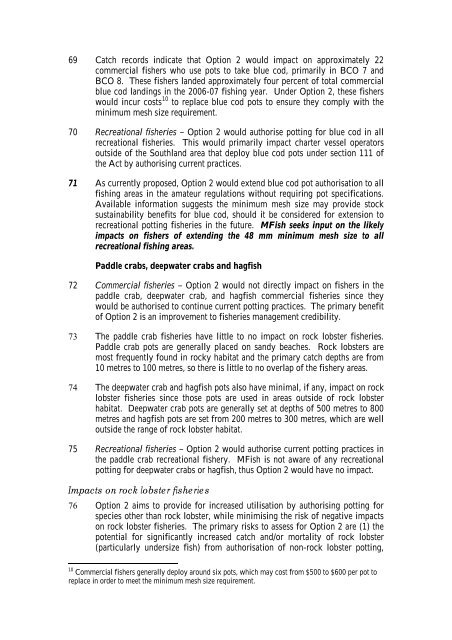review of potting definitions - Ministry of Fisheries
review of potting definitions - Ministry of Fisheries
review of potting definitions - Ministry of Fisheries
You also want an ePaper? Increase the reach of your titles
YUMPU automatically turns print PDFs into web optimized ePapers that Google loves.
69 Catch records indicate that Option 2 would impact on approximately 22<br />
commercial fishers who use pots to take blue cod, primarily in BCO 7 and<br />
BCO 8. These fishers landed approximately four percent <strong>of</strong> total commercial<br />
blue cod landings in the 2006-07 fishing year. Under Option 2, these fishers<br />
would incur costs 10 to replace blue cod pots to ensure they comply with the<br />
minimum mesh size requirement.<br />
70 Recreational fisheries – Option 2 would authorise <strong>potting</strong> for blue cod in all<br />
recreational fisheries. This would primarily impact charter vessel operators<br />
outside <strong>of</strong> the Southland area that deploy blue cod pots under section 111 <strong>of</strong><br />
the Act by authorising current practices.<br />
71 As currently proposed, Option 2 would extend blue cod pot authorisation to all<br />
fishing areas in the amateur regulations without requiring pot specifications.<br />
Available information suggests the minimum mesh size may provide stock<br />
sustainability benefits for blue cod, should it be considered for extension to<br />
recreational <strong>potting</strong> fisheries in the future. MFish seeks input on the likely<br />
impacts on fishers <strong>of</strong> extending the 48 mm minimum mesh size to all<br />
recreational fishing areas.<br />
Paddle crabs, deepwater crabs and hagfish<br />
72 Commercial fisheries – Option 2 would not directly impact on fishers in the<br />
paddle crab, deepwater crab, and hagfish commercial fisheries since they<br />
would be authorised to continue current <strong>potting</strong> practices. The primary benefit<br />
<strong>of</strong> Option 2 is an improvement to fisheries management credibility.<br />
73 The paddle crab fisheries have little to no impact on rock lobster fisheries.<br />
Paddle crab pots are generally placed on sandy beaches. Rock lobsters are<br />
most frequently found in rocky habitat and the primary catch depths are from<br />
10 metres to 100 metres, so there is little to no overlap <strong>of</strong> the fishery areas.<br />
74 The deepwater crab and hagfish pots also have minimal, if any, impact on rock<br />
lobster fisheries since those pots are used in areas outside <strong>of</strong> rock lobster<br />
habitat. Deepwater crab pots are generally set at depths <strong>of</strong> 500 metres to 800<br />
metres and hagfish pots are set from 200 metres to 300 metres, which are well<br />
outside the range <strong>of</strong> rock lobster habitat.<br />
75 Recreational fisheries – Option 2 would authorise current <strong>potting</strong> practices in<br />
the paddle crab recreational fishery. MFish is not aware <strong>of</strong> any recreational<br />
<strong>potting</strong> for deepwater crabs or hagfish, thus Option 2 would have no impact.<br />
Impacts on rock lobster fisheries<br />
76 Option 2 aims to provide for increased utilisation by authorising <strong>potting</strong> for<br />
species other than rock lobster, while minimising the risk <strong>of</strong> negative impacts<br />
on rock lobster fisheries. The primary risks to assess for Option 2 are (1) the<br />
potential for significantly increased catch and/or mortality <strong>of</strong> rock lobster<br />
(particularly undersize fish) from authorisation <strong>of</strong> non-rock lobster <strong>potting</strong>,<br />
10 Commercial fishers generally deploy around six pots, which may cost from $500 to $600 per pot to<br />
replace in order to meet the minimum mesh size requirement.

















